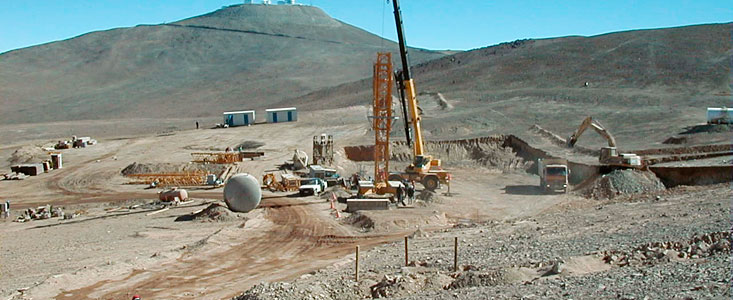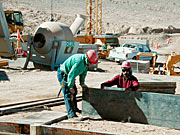Communiqué de presse
A Home in the Desert
28 juillet 1999
The Paranal Observatory, site of ESO's Very Large Telescope (VLT) , is a long way from anywhere. Located in the northern part of the Chilean Atacama Desert, one of the driest areas of the world, it is also the working place for about one-hundred ESO staff members, some from Chile and others from Europe. Paranal was an empty mountain when the construction of the ESO observatory began here in 1991. Since then, a small community has sprung up at this desolate site. A significant investment has been made here to establish the complex infrastructure that is needed to ensure the proper running of this high-tech research facility. Everything has to be trucked in, from water and food to telescope spare parts. Electricity is generated by several diesel motors that maintain a stable power supply to the sensitive astronomical instruments and also to all devices needed for a minimum of comfort for the staff and visitors. From the outset, they have been living in housing containers at the "Base Camp". The workers and engineers of the contracting firms have also been living in similar quarters across the main road that leads to the telescopes at the top of the mountain.
The Paranal Residencia and Offices
As this was the case at La Silla some three decades ago, it has always been ESO's intention to provide better quarters and living facilities at Paranal. Plans for the design and construction of the "Facilities for Offices, Board and Lodging", also known as the Paranal Residencia and Offices , were therefore begun some years ago.
The project was developed by Auer and Weber Freie Architekten from Munich (Germany). Their design was selected among eight proposals from European and Chilean architects. The Chilean firm Vial y Vives won the construction tender. Work on the first part of the building began on July 1, 1999, and is scheduled to be completed within two years.
The unusual conceptual design is structured as an L-shaped building, located downhill from the Paranal access road on the south-west side of the present Base Camp.
The building is fully integrated into the landscape, essentially underground with its southern and western facades emerging from the ground, providing a view from the bedrooms, offices and restaurant towards the Pacific Ocean.
The common facilities, restaurant, offices, library, reception and meeting rooms are articulated around the corner of the building, while the hotel rooms are distributed along the wings of the L-shape.
A circular hall, 35 m wide and four floors deep - covered with a dome emerging at ground level - is the building's focal point with natural light. At the floor of the hall there is an oasis of vegetation with a swimming pool. Special protection against light pollution is foreseen. To a large extent, the ventilation is with natural airflow through remotely controlled air in outlets.
Other activities at Paranal
Astronomical observations continue with ANTU (UT1), while the large spectrograph UVES is being unpacked after successful transport from ESO HQ in Garching (Germany). It will then be mounted at one of the Nasmyth foci of KUEYEN (UT2) and test observations will start soon thereafter.
The assembly of MELIPAL (UT3) and YEPUN (UT4) proceeds well. The installation of M1 Cell (in which the third 8.2-m Zerodur mirror will rest) will soon begin at MELIPAL .
More information about this work and new photos from Paranal will become available on the web over the next weeks.
A propos du communiqué de presse
| Communiqué de presse N°: | eso9937 |
| Legacy ID: | Photo 31a-d/99 |
| Nom: | Paranal, Paranal Residencia |
| Type: | Unspecified : Technology : Observatory : Facility |
| Facility: | Very Large Telescope |




